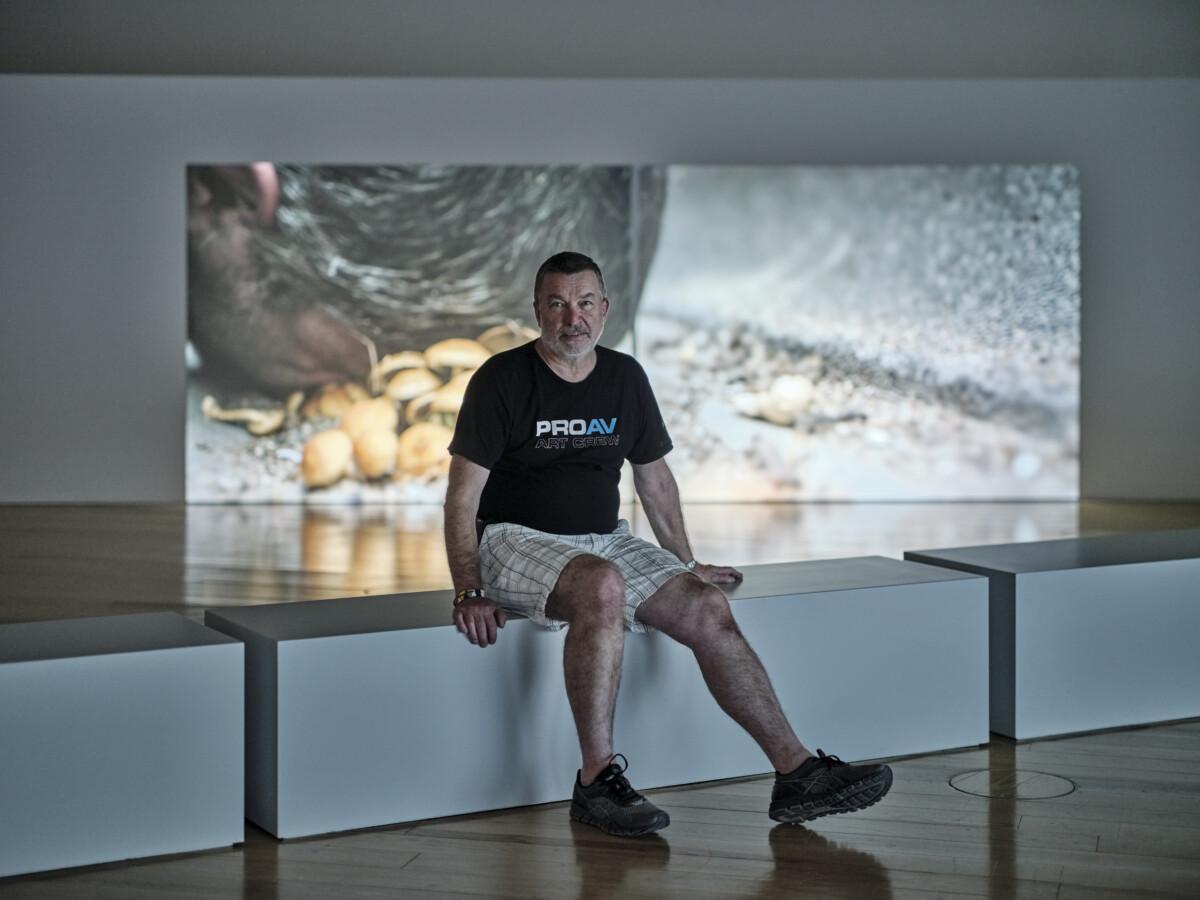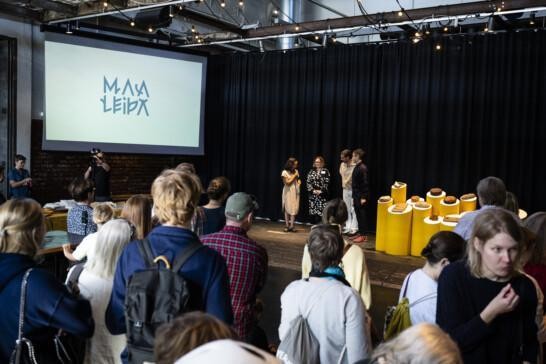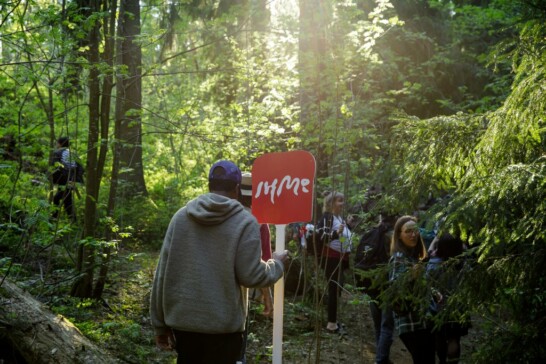Ecoblog
On the sustainability of video art

Interview with Jorma Saarikko
IHME Helsinki Commission 2025 is Zhanna Kadyrova’s video installation The Forest. It opens to the public at the Voimalamuseo (Power Plant Museum/Steam Power Plant) at Vanhankaupunginkoski rapids in August. The installation work will be done by Pro Av Saarikko Oy, a pioneering company familiar to many in the media-art display sector.
IHME Helsinki aims to be ecological in its own activities and to aid in the sustainability transition in the visual arts by sharing what we have learned with other actors in the field.
We asked Jorma Saarikko about the environmental aspects of showing video art. How can media art be exhibited in an ecologically sustainable way?
Who are you and what is your connection with video art?
I am Jorma Saarikko, founder and owner of Pro Av Saarikko. I was introduced to media art in the 1980s and started helping out Finnish video artists while working at Finland’s first hi-fi store, Kruunuradio. At the time, there was a great need for technical expertise in the arts, and I myself got very passionate about helping artists. I have always been interested in solving problems, and media art is actually full of them.
I started my own company, Pro Av Saariko, in 1992. It focuses on the technical side of implementing media art. We also try to find new ways of using technology and offering these possibilities to artists, without interfering in any way with the content.
In 1999, when I was in the Louvre in France, I saw the Mona Lisa. By that time, I had become so familiar with media art that I had seen huge numbers of “out of order” labels on media-art works all over the world.
It seemed totally incomprehensible that one painting could be on the wall for three hundred years, but media art could not. That’s when I decided that there would be no “out of order” notices coming from me. And I have stuck to that.
Today, Pro Av Saarikko concentrates on designing, implementing, renting out, and selling technical solutions for artists, museums and galleries to enable them to present their artistic vision. In Finland we work with artists, galleries and museums, such as Amos Rex and HAM.
But 70% of our turnover comes from abroad, and we have, for example, been providing media solutions for the Venice Biennale, the Lofoten Biennale, and the Istanbul Biennale for some 30 years now. We also work with major museums abroad.
What are the emission sources and sustainability aspects in video art?
Key emission sources in displaying video art include the manufacture of the presentation equipment, the manufacture of projection surfaces and other aspects of the installation, energy use, logistics, and the waste generated. Transport is a key source of emissions, particularly for international ventures.
In the past, for example, video projectors used lamps containing mercury, and the lamp waste generated was enormous. In 2016, I personally decided that I would try to convert our gear to green technology as far as possible. Since 2017, we have only purchased new equipment that does not contain hazardous components.
This shift was partly made possible by the development of laser projectors. Today, we only use laser-light sources in our new projectors, and LED technology in monitors. Laser light projectors and LED technology do not need lamps to be replaced and are very energy efficient.
We ourselves source our new equipment mainly from EU-regulated manufacturers, such as Epson and Panasonic. EU regulation is good, for example, on recyclability, and my own experience is that large companies are on average more serious about going green than small ones.
For audio equipment we ourselves prefer the Finnish company Genelec, which has long taken sustainability into account in its operations. In addition, we purchase our equipment custom-made, which allows us to have a say in its eco-friendliness.
Of course, we also have some old technology, since some works require a specific technology (such as a VHS recorder) to display them. Personally, I feel that old technology is also a picture of its time and valuable in itself. We maintain and repair old equipment so that the existing equipment can be used for as long as possible.
The energy consumed by our equipment has in turn fallen significantly, to about one third of what it was ten years ago.
What ecological choices can be made when showing a video work (for example, in terms of equipment or space)?
In general, renting display equipment is more sustainable than buying, not least because the technology ages rapidly.
In Finland, there still seems to be an idea that it is better to invest in display equipment. But, if a museum buys, say, three projectors, very soon their quality will no longer be up to date and they will end up in storage collecting dust.
In the US, for example, museums only rent equipment for display purposes. They don’t buy anything, because they think buying consumes too much.
When choosing projection surfaces and other building materials for an installation, it is also worth paying attention to the eco-friendliness and recyclability of the materials. At some point, I noticed that projection surfaces for exhibitions were built out of wooden panels, which were then taken straight to landfill after the exhibition.
We have opted to use aluminium-based frames, which provide top-quality, recyclable projection material. We are able to use the same material for dozens of exhibitions before it has to be replaced.
In your experience, how do artists, venues or curators deal with ecological issues in Finland and abroad?
– in other words, how common is it for video-art display practices to be expected to be ecological?
Other parts of the world are much more advanced than Finland in taking ecological issues into account. For example, the de Young Museum in San Francisco is currently showing an exhibition by Isaac Julien, where Pro Av Saarikko has just over sixty projectors or screens. The Museum calculated the exhibition’s carbon footprint, and asked us for, among other things, consumption figures for the electricity used by our equipment. The obligation to provide a calculation was written into our contract.
The focus on the eco-friendliness of the equipment has slightly increased purchasing costs, but it has also brought us more clients, as our international partners have appreciated our ecological approach.
When I work in Finland, I myself often raise the issue of sustainability with the various parties. Perhaps that is why I have not been asked much about the subject, since it has already come up.
I have, however, noticed that some Finnish museum institutions, for example, have become aware of the sustainability aspect. For instance, HAM’s Helsinki Biennale tried to make an accurate calculation of the carbon footprint of the first Biennale.
Personally, I hope the sustainability aspect will be turned up even more strongly and more quickly as a self-evident part of the art scene.
Is there a conflict between spectacular presentation of an artwork and ecological values?
Often, massive, spectacular presentation increases the carbon footprint, as well as other sustainability problems. For example, in 2018, we put up an immersive video installation called teamLab at Amos Rex. It was the biggest media art exhibition in Europe in 2018.
It involved 12 kilometres of cable and 132 high-powered projectors. The exhibition as a whole was a massive project.
When the exhibition was open, every day, there were 100-metre queues outside. So, it must have brought lots of new visitors into the world of exhibitions. When I thought about that, I couldn’t in a way feel sorry about the massiveness of the exhibition, even if I am a bit ambivalent about it.
How can artists influence the way that their work is presented in an environmentally responsible manner?
When starting to design a work, the artist can begin by outlining the basic sustainability aspects of the working process, and incorporate them into the design from the outset. They can seek collaborators who can help and advise them on these issues. Venues and collaborators can also be assumed to be bearing sustainability in mind.
I have, for example, accumulated a lot of knowledge over the years about both displaying video art and its sustainability, and I feel it is really important to share that knowledge. When I work with artists, we often think together about what we can do for each piece.
As logistics is a major source of emissions in video art, I also take this into account in my own proposals.
I have also given lectures on the sustainability of display solutions. If I have the time, I am happy to advise anyone at any time on these issues.
IHME 2025 is a video work by Ukrainian artist Zhanna Kadyrova, installed by Pro Av Saarikko. How is sustainability taken into account in this work at the Voimalamuseo?
Zhanna Kadyrova’s work will be installed using 100% recyclable laser-light projectors and a media player, which IHME Helsinki will rent for the exhibition. The equipment will not stop being used after the exhibition, but, as it ages, we will ensure that it is recycled for reuse.
Since AV equipment still contains expensive components, there are also operators in the sector whose business is based on dismantling and recycling it. 100% of recyclable equipment can be dismantled and hence recycled in its entirety.
During the exhibition, the media player plays a video piece automatically and can be operated from our own premises. This allows us to avoid unnecessary trips to the equipment. We will also install other display technology for the exhibition at the Voimalamuseo. It is both cost-effective and environmentally friendly to have one company do the whole job.
Pinja Valja
Working on her diploma work for Specialisation programme in climate expertise. Pinja was responsible for Eco-Coodinator’s tasks in IHME Helsinki during the spring 2025.
Translated with the help of AI, edited by MG


